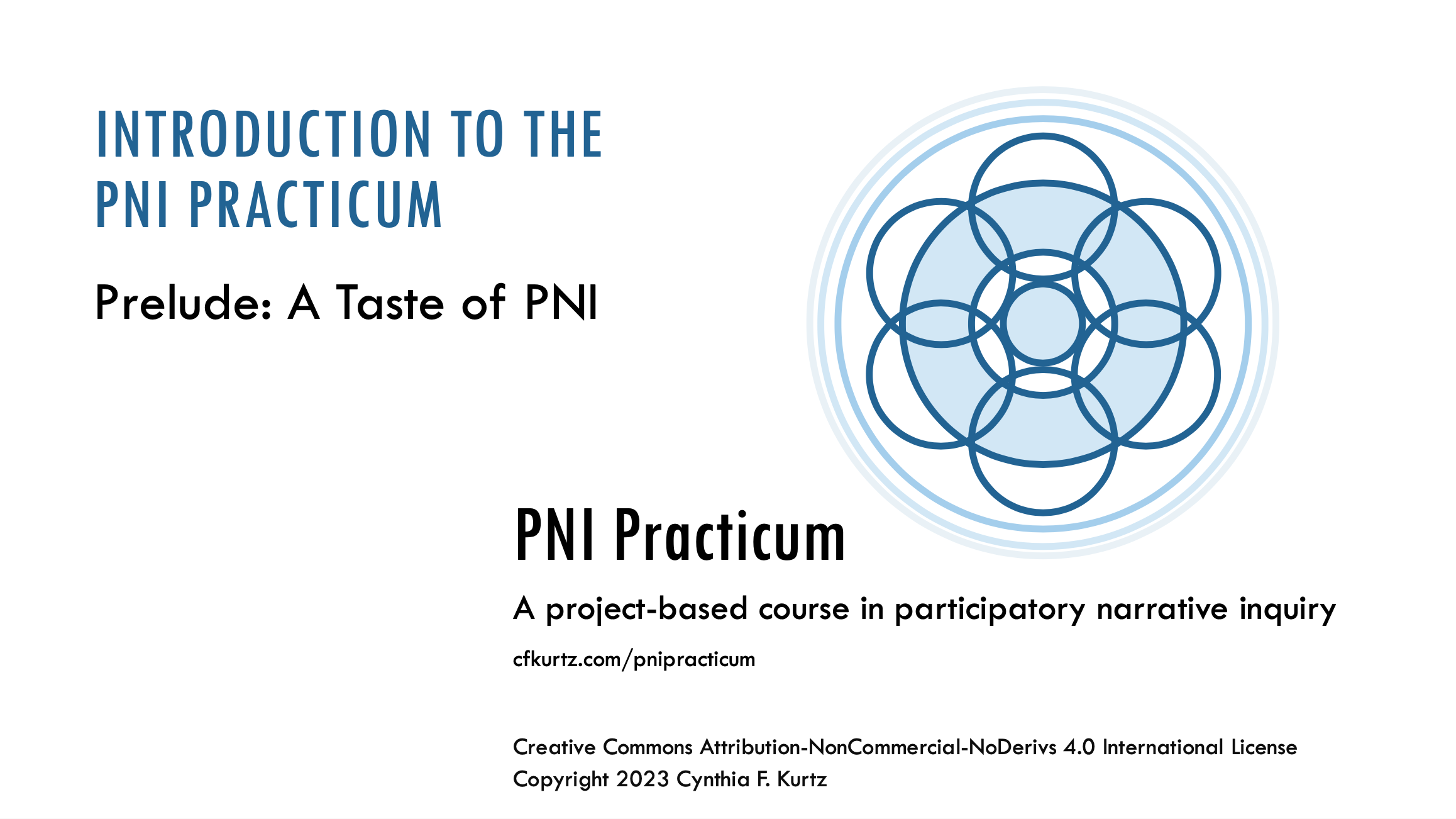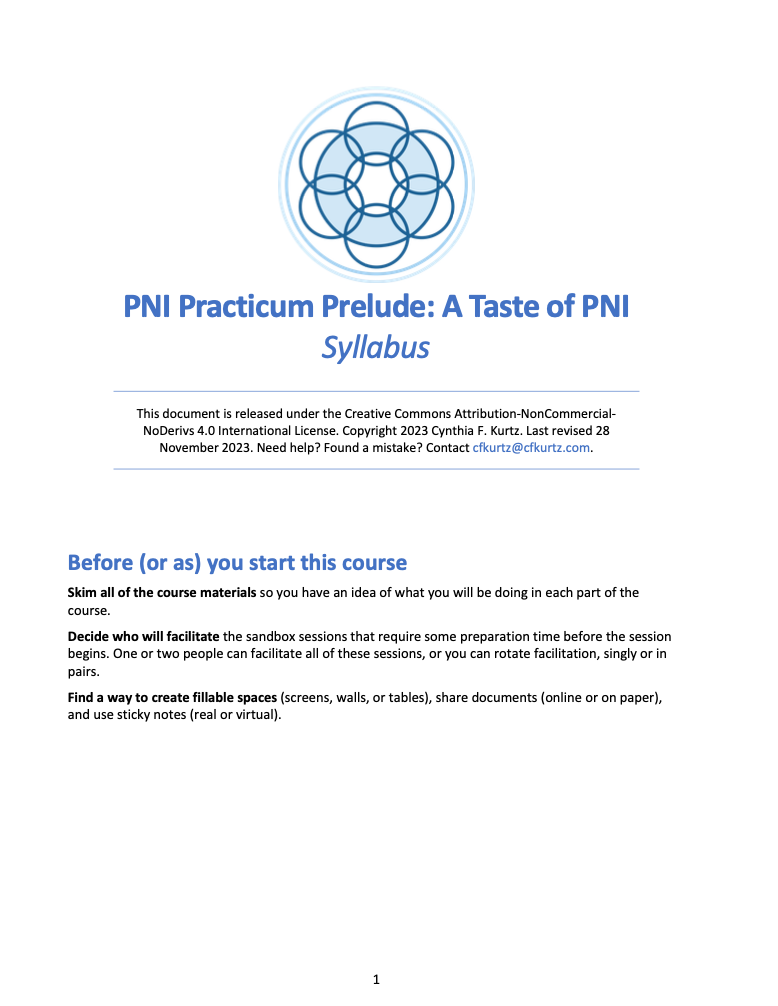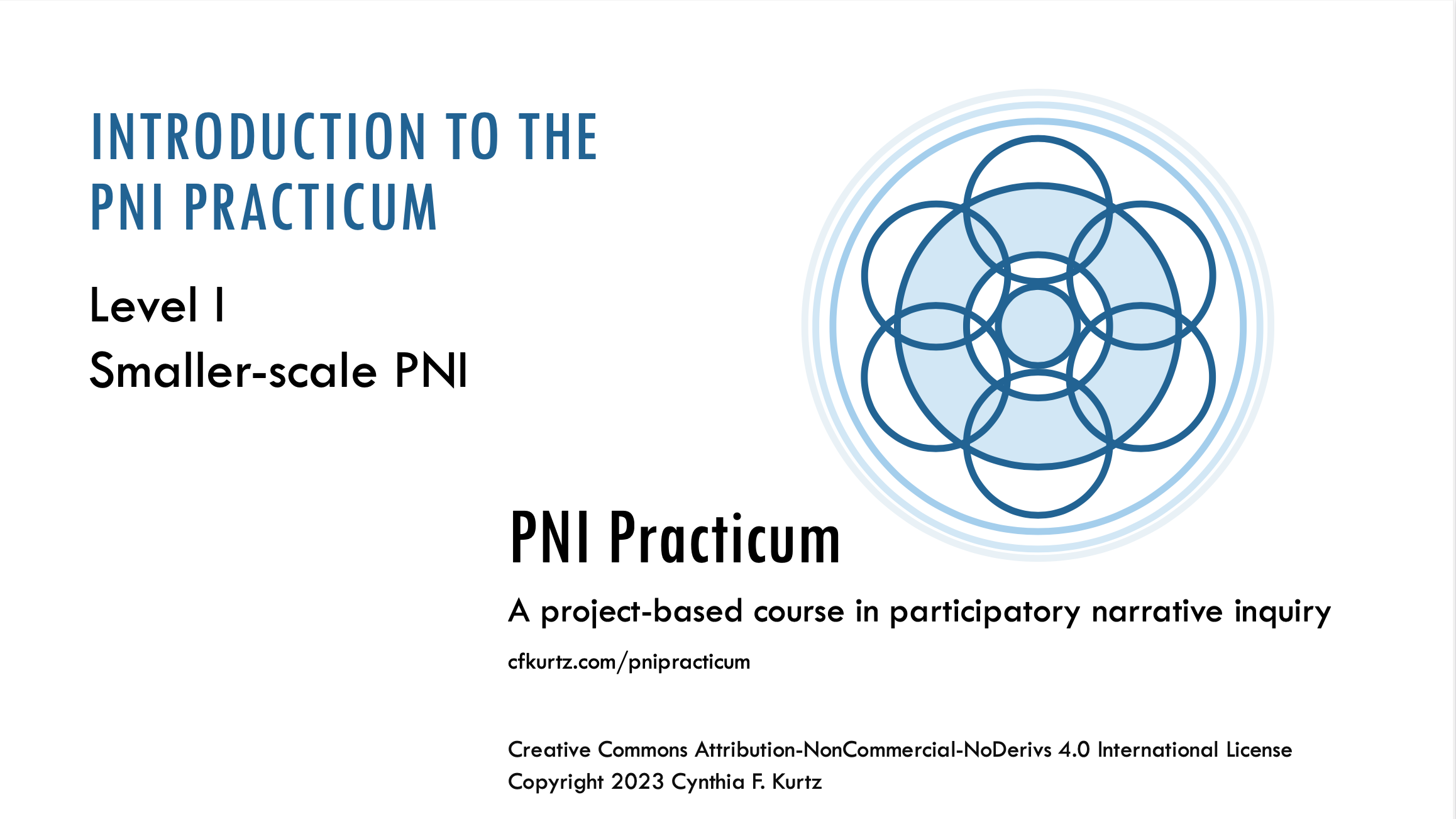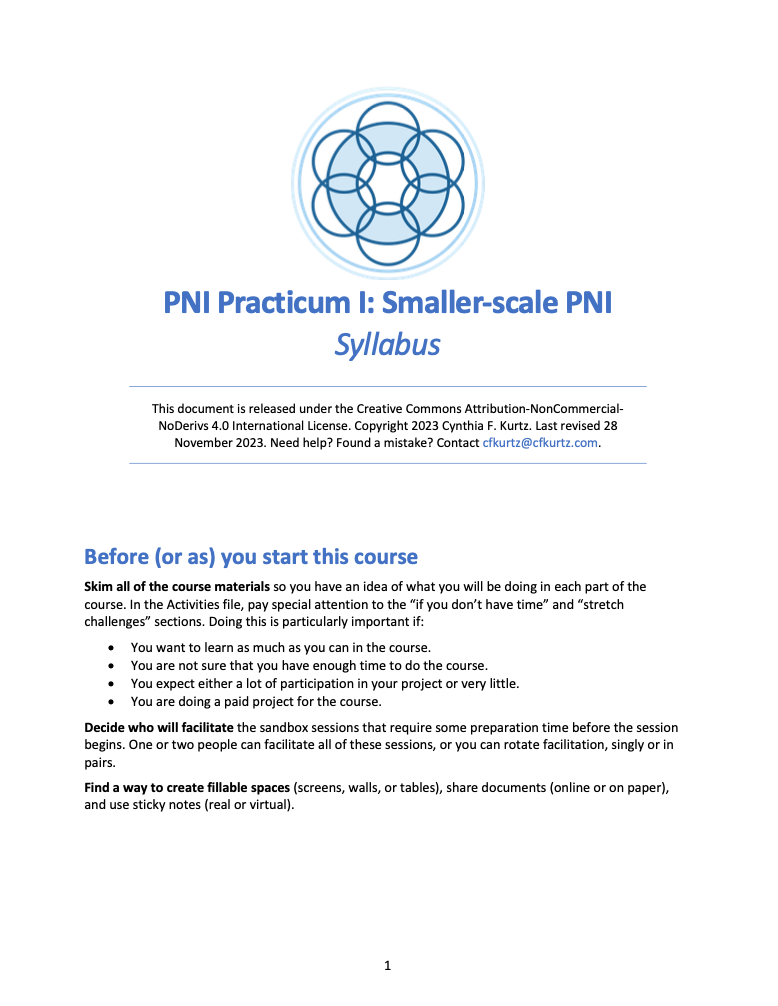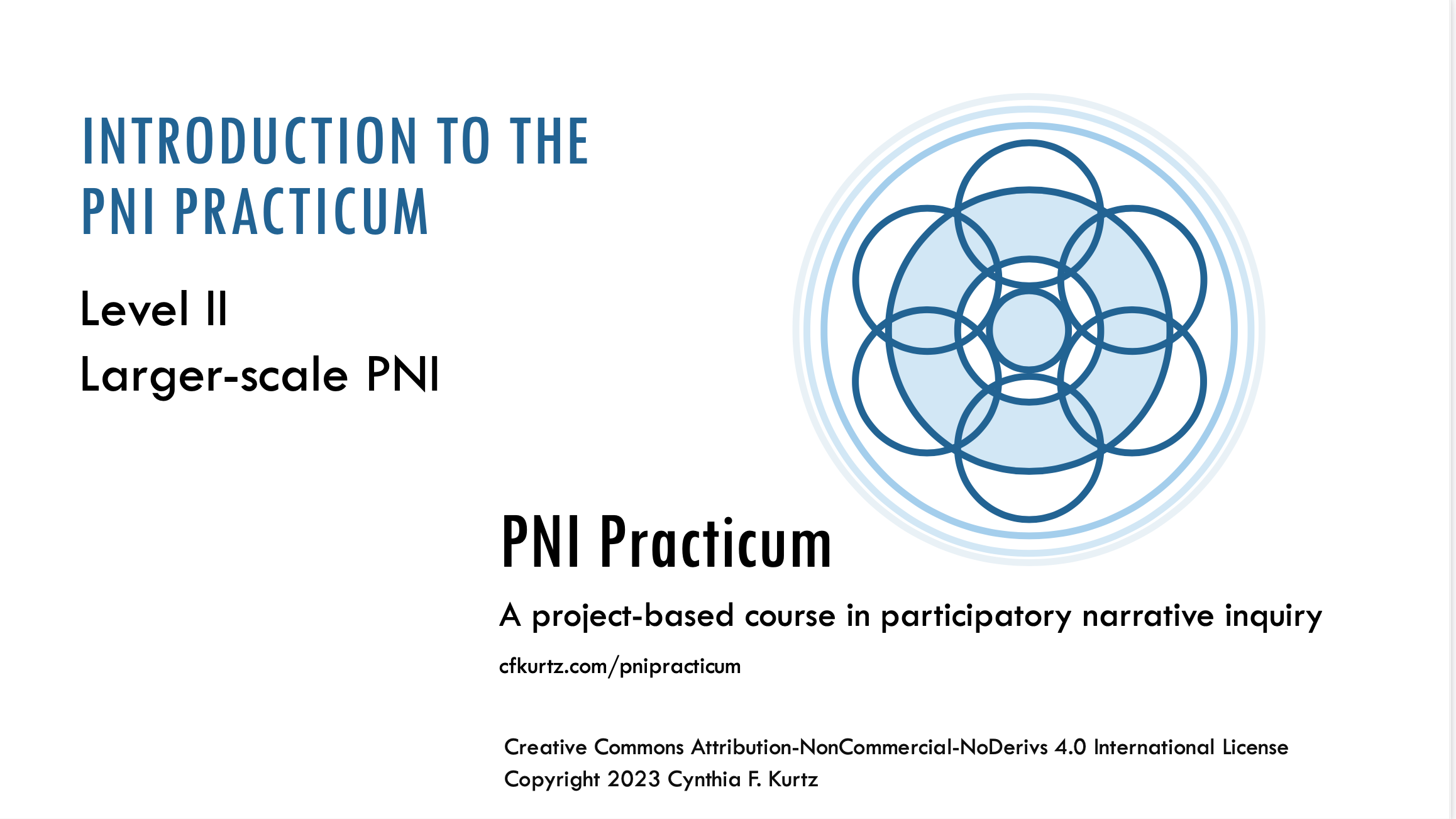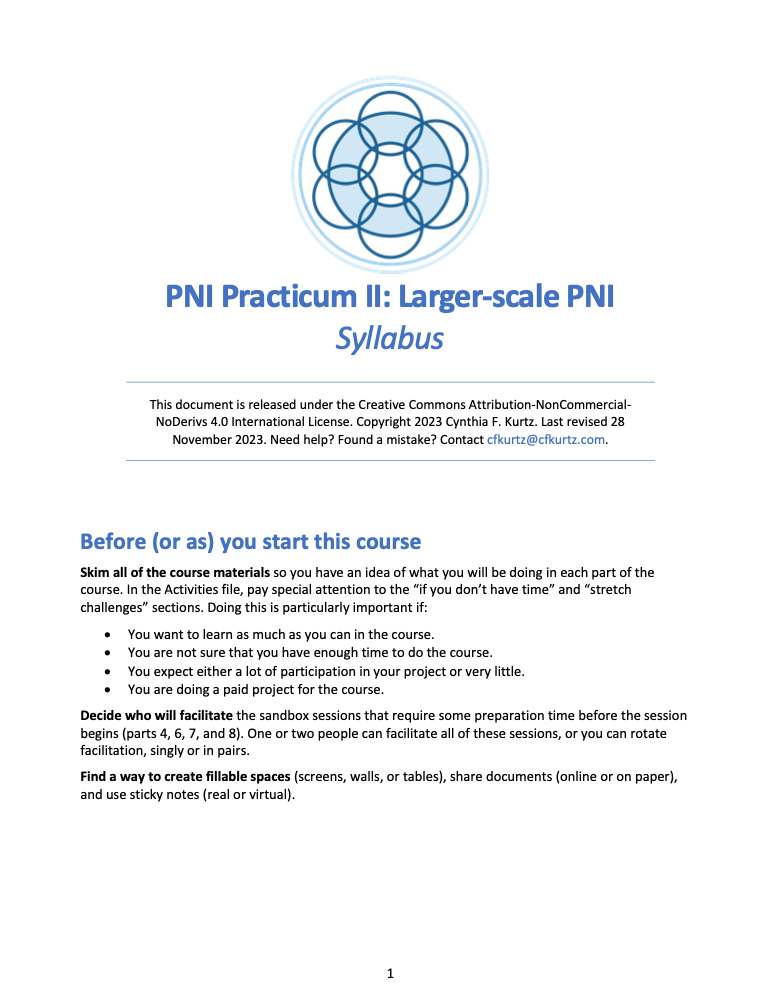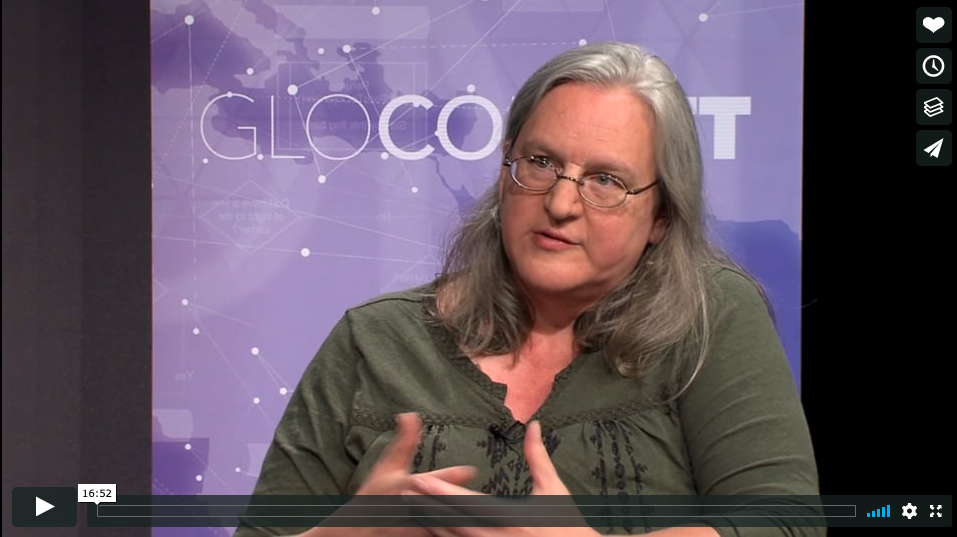Questions about taking and giving a PNI Practicum course
Our group has only three people in it. Can we still take one of these courses?
The PNI Practicum courses require a cohort of seven people for two reasons:
seven is enough to have two good story-sharing groups plus one facilitator,
and seven is enough to provide useful peer support in a group discussion.
But there is a second fall-back not-quite-so-good minimum: four people.
With that number you can still have one good story-sharing group plus a facilitator,
and though your peer support will be weaker, it will probably be adequate.
However, I do not suggest taking any of the courses with fewer than four people.
I don't have a group; I'm just one person. How can I take a PNI Practicum course?
Ask around among your friends and colleagues. Mention the course on social media. Join the
Participatory Narrative Practitioner Network
and see if anyone there wants to join you in forming a cohort.
I'm a consultant. Can I offer a PNI Practicum course to my paying clients?
No.
Commercial (for pay) use of the PNI Practicum materials in whole or in part is prohibited by the current license
(CC BY-NC-ND).
You can only give the course for free and exactly as it was written.
My intent in choosing this license was to help small groups of people work through the course materials together.
If you are interested in using the PNI Practicum course materials as part of a business venture or consulting package,
please contact me at cfkurtz@cfkurtz.com.
We can negotiate a fee for a one-time limited-duration license that allows commercial use of the course materials.
We've chosen a course and downloaded the materials. What do we do next?
- Look at the course description and syllabus. Make sure everyone has time to do the readings and activities required.
- Choose a time to meet.
- Decide who is going to moderate the seminar meetings and facilitate the sandbox meetings.
- Start your first session, following the instructions in the course description and syllabus.
Use the sandbox and activity instructions to help you plan and carry out each part of the course.
We're confused about who is supposed to lead the seminar calls and facilitate the sandbox sessions.
Anyone can take the lead in going through any of the PNI Practicum courses together.
That person (or those people) will need to spend more up-front time reading
and preparing for each meeting so they are ready to help everyone else follow the course schedule and activities.
You might want to give lead roles to those among you who:
- have the greatest enthusiasm to learn how to do PNI
- come into the course knowing the most about PNI or story work or facilitation
- have the most free time to put into preparation
Can we all take the lead on facilitation?
Sure. In that case, it might be a good idea to rotate the facilitation of each meeting, with everyone taking a turn
reading and preparing.
Can our whole group collaborate on one project?
Only if it's a big enough project to give everyone a chance to practice doing all of the course activities.
If not, I suggest doing a few related projects,
each with 2-3 collaborators, so everyone has a chance to practice the work.
Our group has done some story work before, but not PNI. Which course do you suggest we take?
To begin with, the Prelude course is so short and light as to be not really a practicum course at all.
If you have very little time, or you have never done any story work before,
or you are not sure that you want to use PNI, the Prelude is the best course to take.
If you have done story work before, you might want to use PNI in one of two ways.
-
The ancient, artisanal style of PNI is simple and clear. You gather some stories, then help a group of people make sense of them together.
It's the sort of thing that could have happened (and probably did happen) thousands of years ago.
-
The modern, scalable style of PNI is complicated and ambitious. You gather some stories, and you also gather a lot of answers to questions about
the stories and their tellers. Then you look for patterns in the answers to find "food for thought" people can use to explore the
topic more fully than they can with the stories alone. To do this style of PNI, you need to collect more stories,
generate and review graphs and statistical test results, prepare patterns for use in sensemaking, and
facilitate a more intense and demanding form of sensemaking in which people make sense of both stories and patterns.
I know some people who do only the ancient style of PNI, some who do only the modern style, and some who do both.
The ideal is to be able to do either style as the situation calls for it. But there is also an element of personal preference involved.
Some people gravitate more naturally to one style or the other.
One thing that might help you decide is to look at the example catalysis report
(of patterns prepared for sensemaking)
that I have on my web site (it is actually some excerpts from a longer report I built for a project).
This is the sort of thing you would be creating to support sensemaking in a modern-style PNI project
(the kind you would be doing in the PNI Practicum II course).
If you can see yourself enjoying the work of creating a report like that — if that is the sort of thing you want to learn how to do —
then the PNI Practicum II course would suit you best. If that sort of thing seems boring or stupid or overwhelming to you,
then you would probably like the PNI Practicum I course better.
Questions about consulting support for the PNI Practicum courses
Could you just run a PNI Practicum course for us?
Maybe. It depends on what else I am doing at the time. The fee to run a full course is typically between US$10K and US$20K,
depending on particulars.
If you are interested in this option,
send me a note at cfkurtz@cfkurtz.com.
We have a budget, but we don't think we will be able to pay for a whole course. What do you suggest?
You have two options.
- You can distribute your budget across the course, asking me to spend some time with you for (say) an hour each week or month,
helping you in whatever way suits your needs at the time. (If you choose this option, it might be a good idea
to end each of your meetings with a compilation of questions to ask during your next meeting with me.)
You can concentrate your budget at specific times you think you will need extra help.
I've coached a lot of people who were doing their first PNI projects,
and I've found that the times people most often want help are:
- When they have their project plans ready (including the questions they plan to ask)
and want some advice and feedback to help them avoid common pitfalls.
- When they have their stories and are ready to take their first steps toward preparing catalytic material for use in sensemaking.
- When they have their sensemaking session agendas ready and want feedback on them.
I've also noticed certain times when people often need troubleshooting help. For example:
- When they need help pitching their project to leaders or funders.
- When they are having trouble getting people to participate in the project.
- When their story collection isn't going well —
people are upset or apathetic, people are telling surface-level or performative stories, and so on.
- When they are struggling with some of the technical aspects of gathering data and generating graphs and statistical results.
- When they need help ending their project well by proving its value to its funders and/or participants.
When you think about the projects you would like to do as you take a PNI Practicum course,
in which of the above areas do you think you
will need help, and in which areas do you think you will be fine on your own?
If you can answer that question now, we can plan some support sessions into your course at those important times.
If you can't answer that question now, we can set up a budget you can dip into as the need arises.
Depending on what else I am doing at the time, I may or may not be able to help you in an as-needed way;
but it's not out of the question, and I should be able to assess my availability before you start your course.
We like what you have here, but we want a slightly different course. Could you build us a bespoke version?
Possibly. Send me a note at cfkurtz@cfkurtz.com and we'll talk about it.
Can you help us take a PNI Practicum course pro-bono?
I might be able to meet with you for an hour or two, depending on how busy I am.
Send me a note at cfkurtz@cfkurtz.com.
Questions about the PNI Practicum Prelude Course
Does the shared project have to be about learning?
No. You can replace the learning topic with another topic of your choice.
Open the editable versions of the files and change all of the topic-specific aspects of the materials provided, such as
the eliciting and reflective questions, dimensions used in the exercises, and so on.
You can use the Working with Stories Simplified chapter on Story collection to guide you in writing good questions.
It might take a little while, but it's definitely doable.
(If you need help converting the course to a new topic, you might want to pay me to help out for an hour or two.)
Remember that under the terms of the open-source license, you can only distribute your modified files within your course cohort.
Questions about your course project (for the PNI Practicum I and II courses only)
I have a project in mind, but I'm not sure it will work in the course.
Projects done in the I or II-level PNI Practicum courses should be
synchronized (on the same schedule),
not secret (something you can talk about),
and exploratory (small enough to fit into our time frame).
I can't think of any project to do. Is that a problem?
Not necessarily. Participants are more important than projects.
If you can find at least 6 (for the PNI Practicum I) or 20 (for the PNI Practicum II)
friends, colleagues, family members, or members of your community or organization
who you are pretty sure will be willing and able to spend some time participating in your project,
you can decide on the project's topic (maybe in discussion with your participants)
as the course begins.
Do my project participants need to have a lot in common? For example, do they need to live or work at the same place?
No. You can do a project with people who have nothing in common
except a mild to moderate interest in the topic of your project.
In fact, I've worked on many projects just like that.
Do I have to identify all of my project participants before the course begins?
It depends.
If the pool of people from whom you can draw participants is small (say just enough to do the project),
you will need to get them to agree to participate before you start the course,
so you can be certain that you can fill your
interviews and sessions with participants.
However, if your pool of potential participants is much larger than the number of participants you need,
you can invite people to participate as the course goes along.
For example, you might gather some of your stories by simply hanging out at a local gathering place
and finding people who are willing to share a story or two.
For details on when each interview and session will take place,
and how much time you will need to ask people to spend on it,
see the page titled "Project Activities" in the
PNI Practicum descriptions (I-level, II-level).
(Also see the "If you fall behind" page.)
Can I use a PNI Practicum course to do a project I get paid to do?
Yes, but make sure the course schedule aligns with your client's expectation of what will happen.
My suggestion is to look at the course schedule and make sure a project with that schedule and scope will meet your client's needs.
Questions about the PNI Practicum I course
I don't think I can find any project participants. What do you suggest?
Ask around among your family, friends, neighbors, and colleagues.
Most people can convince (drag, bribe, guilt)
at least a few people to spend a few hours sharing stories around an interesting topic.
Say "I'm taking a class!" and offer pizza or donuts.
Also, you might be able to collaborate on a project with another student.
For example, if three students were to bring two participants each into a shared project,
they could do the project as a team and take turns facilitating.
Students can also act as participants in each other's projects.
Why doesn't the PNI Practicum I course use NarraFirma?
You can use NarraFirma if you want to. It's a good place to plan your project, organize your stories, and record your reflections.
However, you may not want to learn how to use a new piece of software in this course.
And since you will be collecting relatively few stories, it's not necessary to do so.
Your favorite word processor will work fine. Even pen and paper will work fine, if you like that better.
The only software you absolutely need to use in this course is your internet browser, to participate in meetings.
Questions about the PNI Practicum II course
Will we be required to use NarraFirma?
Yes. Everyone will be using NarraFirma.
You will use it to plan projects, gather stories, discover patterns, build catalytic material for sensemaking, and record reflections.
What do we have to do to get NarraFirma set up to use in the course?
The simplest method is to pay for a basic account
at a one-click WordPress hosting site.
Make sure the host you choose allows custom plugins.
Once you have WordPress running, you can install NarraFirma (from the WordPress plugins directory) in a few clicks.
Do we all need need to do this separately?
No. If one person in your course cohort sets up NarraFirma on a web service, everyone else can use it as well.
Just ask them to set up different projects with different permissions.
(You might want to ask the most tech-savvy person in the group to take care of this task.)
Do we have to set up NarraFirma before the course starts?
No, but you should do it within the first few weeks of the course.
Can we install NarraFirma locally, not on the internet?
Yes. But you'll have to import or enter your stories
instead of using NarraFirma to collect them over the internet.

